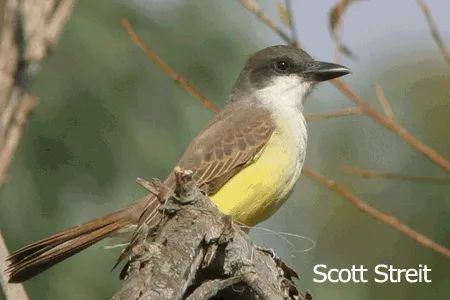
Thick-billed Kingbird
[order] PASSERIFORMES | [family] Tyrannidae | [latin] Tyrannus crassirostris | [UK] Thick-billed Kingbird | [FR] Tyran brun | [DE] Dickschnabel-Tyrann | [ES] Tirano Piquigrueso | [NL] Diksnavelkoningstiran
Subspecies
| Genus | Species | subspecies | Breeding Range | Breeding Range 2 | Non Breeding Range |
| Tyrannus | crassirostris | NA, MA | sw USA to Guatemala | ||
| Tyrannus | crassirostris | crassirostris | |||
| Tyrannus | crassirostris | pompalis |
Physical charateristics
A large kingbird with an outsize bill ; differs from similar kingbirds in having a dark cap and back and whitish
underparts. However, autumn birds may be quite yellow below.
underparts. However, autumn birds may be quite yellow below.
Listen to the sound of Thick-billed Kingbird
[audio:http://www.aviflevoland.nl/sounddb/T/Thick-billed Kingbird.mp3]
Copyright remark: Most sounds derived from xeno-canto
| wingspan min.: | 0 | cm | wingspan max.: | 0 | cm |
| size min.: | cm | size max.: | cm | ||
| incubation min.: | 0 | days | incubation max.: | 0 | days |
| fledging min.: | 0 | days | fledging max.: | 0 | days |
| broods: | 0 | eggs min.: | 0 | ||
| eggs max.: | 0 |
Range
North America, Middle America : Southwest USA to Guatemala
Habitat
Sycamores and cottonwoods along streams. In the United States, breeds alo
ng permanent streams in the lowlands and lower canyons; mostly where big sycamores and cottonwoods grow, occasionally in pure stands of cottonwoods. In Mexico, widespread in dry woods and semi-open country in lowlands.
ng permanent streams in the lowlands and lower canyons; mostly where big sycamores and cottonwoods grow, occasionally in pure stands of cottonwoods. In Mexico, widespread in dry woods and semi-open country in lowlands.
Reproduction
Breeding behavior is not well known. Aggressive in defense of nesting territory, attacking larger birds that come near nest. Both members of mated pairs often perch close together, quivering wings and calling loudly.
Nest: Site is usually high in tall tree (in Arizona, typically in sycamore, sometimes in cottonwood), 50-
80′ above the ground. Nest is a large but loosely built open cup of twigs, grasses, weeds, leaves, plant down. Nest has a ragged look, with twigs sticking out in all directions; from below, eggs may be visible through bottom of nest.
Eggs: 3-4. Whitish, blotched with brown. Details of incubation not well known.
Young: Both parents bring food for young in nest. Development of young and age at first flight not well known.
Nest: Site is usually high in tall tree (in Arizona, typically in sycamore, sometimes in cottonwood), 50-
80′ above the ground. Nest is a large but loosely built open cup of twigs, grasses, weeds, leaves, plant down. Nest has a ragged look, with twigs sticking out in all directions; from below, eggs may be visible through bottom of nest.
Eggs: 3-4. Whitish, blotched with brown. Details of incubation not well known.
Young: Both parents bring food for young in nest. Development of young and age at first flight not well known.
Feeding habits
Insects.
Diet is not well known, but probably is mostly or entirely insects. Large bill size suggests the ability to feed on very large insects; has been seen eating large beetles, cicadas, and others.
Behavior: Forages by watching from a perch and flying out to capture insect
s, returning to perch to eat them. Captures most prey in midair, often in long, swooping flights. Usually hunts from high perches near tops of trees but will forage low, especially in cool weather.
Diet is not well known, but probably is mostly or entirely insects. Large bill size suggests the ability to feed on very large insects; has been seen eating large beetles, cicadas, and others.
Behavior: Forages by watching from a perch and flying out to capture insect
s, returning to perch to eat them. Captures most prey in midair, often in long, swooping flights. Usually hunts from high perches near tops of trees but will forage low, especially in cool weather.
Conservation
This species has a very large range, and hence does not approach the thresholds for Vulnerable under the range size criterion (Extent of Occurrence <20,000 km2 combined with a declining or fluctuating range size, habitat extent/quality, or population size and a small number of locations or severe fragmentation). The population trend appears to be increasing, and hence the species does not approach the thresholds for Vulnerable under the population trend criterion (>30% decline over ten years or three generations). The population size is extremely large, and hence does not approach the thresholds for Vulnerable under the population size criterion (<10,000 mature individuals with a continuing decline estimated to be >10% in ten years or three generations, or with a specified population structure). For these reasons the species is evaluated as Least Concern.

Migration
Western Mexico, western Guatemala. Breeds locally in southeastern Arizona, southwestern New Mexico; rarely in western Texas. Migration:
Summer resident in southeastern Arizona and southwestern New Mexico, arriving in May and departing in September. Strays sometimes wander to lower Colorado River or southern coastal California in fall and winter.
Summer resident in southeastern Arizona and southwestern New Mexico, arriving in May and departing in September. Strays sometimes wander to lower Colorado River or southern coastal California in fall and winter.
Distribution map

